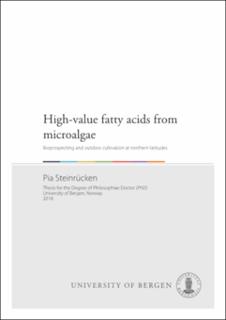| dc.contributor.author | Steinrücken, Pia | |
| dc.date.accessioned | 2018-05-28T07:18:39Z | |
| dc.date.available | 2018-05-28T07:18:39Z | |
| dc.date.issued | 2018-05-11 | |
| dc.identifier.uri | https://hdl.handle.net/1956/17722 | |
| dc.description.abstract | Achieving a sustainable and cost-efficient production is imperative to establish microalgae as a new feedstock for aquaculture, where they can potentially replace the use of fish oil from wild catch as a source for the omega-3 polyunsaturated fatty acids (n-3 PUFAs) eicosapentaenoic (EPA) and docosahexaenoic acids (DHA). Both fatty acids are essential components for higher eukaryotes and are considered highly important for human health. Many marine microalgae naturally produce EPA and DHA and fit greatly as a new, natural and sustainable feedstock. They can be cultivated in large quantities in seawater, on non-arable land and using renewable resources such as sunlight, CO2 and waste streams. However, the high production costs that are associated with large-scale microalgal cultivation and processing need to be reduced. Prospecting for new, robust and fast-growing strains with high n-3 PUFA content, optimizing microalgal strains and cultivation conditions, and improving large-scale productions are essential elements for progressing towards a cost-efficient commercial production, and for an improved development of new and more sustainable feed types for aquaculture. This study focuses on the potential of microalgae from northern latitudes for production of these high value fatty acids. The aim was to find new microalgal strains from different North Atlantic habitats that meet the industrial demand in terms of high EPA and DHA content and growth rates, and to evaluate promising strains in laboratory experiments as well as under outdoor pilot-scale conditions. Microalgae were isolated from Arctic and Fjord-waters and 149 clonal cultures were established. In a first screening round, 20 strains were investigated for their growth rates and fatty acid content under laboratory conditions. Three strains (two strains of Phaeodactylum tricornutum, isolated from the fjord, and one strain Attheya septentrionalis isolated from the Artic) possessed both high growth rates (≥ 0.7 d−1) and EPA content (≥ 3% of dry weight [DW]) (Paper I). The Arctic diatom A. septentrionalis was further investigated in a factorial-design experiment for the individual and interactive effects of irradiance, salinity and growth phase on the EPA content. Growth phase and salinity were identified to significantly affect EPA content in this diatom and the highest EPA content (7.1% DW) was observed after Day 5 in the stationary phase and at low salinity of 22 (Paper II). Finally, one Spanish (Fito) and two local (M28 and B58) isolates of the diatom P. tricornutum were grown for six months in 35 L GWP-III flat-panel outdoor reactors in Bergen, western Norway, to evaluate strain specific productivities under northern climate conditions. Biomass productivities of all three strains were lower compared to results from southern latitudes, most probably due to the lower irradiances. Although the three strains possessed similar biomass productivities (average volumetric productivities of 0.20, 0.18, and 0.21 g L−1 d−1, respectively), different EPA productivities (average volumetric productivities of 9.8, 5.7 and 6.9 mg L−1 d−1, respectively) were observed. The Spanish strain possessed the highest EPA content with an average of 4.4% DW but only under outdoor, and not under laboratory conditions (Paper III). EPA productivities were strongly dependent on both, the strain chosen and the prevailing cultivation condition. The results highlight the great potential of North Atlantic diatoms for the production of high value fatty acids from microalgae. | en_US |
| dc.language.iso | eng | eng |
| dc.publisher | The University of Bergen | en_US |
| dc.relation.haspart | Paper I: P. Steinrücken, S.R. Erga, S.A. Mjøs, H. Kleivdal, S.K. Prestegard (2017). Bioprospecting North Atlantic microalgae with fast growth and high polyunsaturated fatty acid (PUFA) content for microalgae-based technologies. Algal Research 26: 392–401. The article is available at: <a href="http://hdl.handle.net/1956/17719" target="blank">http://hdl.handle.net/1956/17719</a> | en_US |
| dc.relation.haspart | Paper II: P. Steinrücken, S.A. Mjøs, S.K. Prestegard, S.R Erga (2018). Enhancing EPA content in an Arctic diatom: A factorial-design study to evaluate interactive effects of growth factors. Frontiers in Plant Science 9: 491. The article is available at: <a href="http://hdl.handle.net/1956/17720" target="blank">http://hdl.handle.net/1956/17720</a> | en_US |
| dc.relation.haspart | Paper III: P. Steinrücken, S.K. Prestegard, J.H. De Vree, J. E. Storesund, B. Pree, S.A. Mjøs, S.R. Erga (2018). Comparing EPA production and fatty acid composition of three Phaeodactylum tricornutum strains under western Norwegian climate conditions. Algal Research 30: 11-22. The article is available at: <a href="http://hdl.handle.net/1956/17721" target="blank">http://hdl.handle.net/1956/17721</a> | en_US |
| dc.title | High-value fatty acids from microalgae. Bioprospecting and outdoor cultivation at northern latitudes | en_US |
| dc.type | Doctoral thesis | |
| dc.rights.holder | Copyright the Author. All rights reserved | en_US |
| dc.identifier.cristin | 1584505 | |
